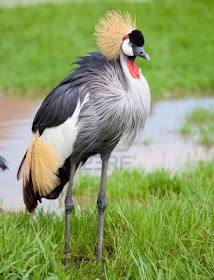 The African crowned crane is the main crane to roost in trees, supporting singular trees with wide sees. They are recognized to be "existing fossils" around cranes, having thrived in the Eocene period exactly 54 to 38 million years back and surviving the ice age. Throughout their mating move, two cranes bounce and bounce elegantly with one another, their wings halfway spread. At that point they open their wings completely, bow to one another, and bounce some feet circulating everywhere. At the time they arrive, they run around one another and begin everywhere on once more.
The African crowned crane is the main crane to roost in trees, supporting singular trees with wide sees. They are recognized to be "existing fossils" around cranes, having thrived in the Eocene period exactly 54 to 38 million years back and surviving the ice age. Throughout their mating move, two cranes bounce and bounce elegantly with one another, their wings halfway spread. At that point they open their wings completely, bow to one another, and bounce some feet circulating everywhere. At the time they arrive, they run around one another and begin everywhere on once more.
This species is not transient despite the fact that it may make variable nearby and seasonal developments relying upon the plenitude and appropriation of nourishment, home destinations and precipitation (del Hoyo et al. 1996). The timing of reproducing differs in connection to the downpours, with the rearing of East African populaces cresting throughout dry periods, yet with the rearing of populaces in the drier parts of southern Africa cresting throughout wet periods.
A few animal varieties and populaces of cranes relocate over long removes; others don't relocate whatsoever. Cranes are single throughout the reproducing season, happening in sets, yet throughout the non-reproducing time of year they are gregarious, structuring expansive herds where their numbers are sufficient.
The cranes have a cosmopolitan dispersion, happening over the greater part of the planet landmasses. They are missing from Antarctica and, bafflingly, South America. East Asia is the core of crane differing qualities, with eight species, accompanied by Africa, which holds five occupant species and wintering populaces of a sixth. Australia, Europe and North America have two species.
The cranes are diurnal flying creatures that differ in their sociality via season. Throughout the rearing time of year they are regional and typically stay on their domain constantly. Conversely in the non-rearing time of year they have a tendency to be gregarious, structuring substantial rushes to perch, socialise and in a few animal groups bolster. Species that eat predominately on vegetable matter in the non-reproducing season sustain in herds to do along these lines, though those that feast upon creatures will ordinarily sustain in family gathers, joining runs just throughout resting periods, or in arrangement for voyage throughout relocation.
Crowned cranes are renowned worldwide for their dating, particularly the mating move between the male and female. The move comprises of weaving, fluttering wings, and swinging rounds around one another. Delegated cranes are typically discovered in sets yet have been seen alone and in minor rushes of 3 to 20 people. There have even been a couple of gatherings of 51 to 150 winged creatures seen! A fruitful match of mated delegated cranes keeps its family aggregate together for a year. After that, the youthful fowls frequently shape their own particular group and invest much of their time encouraging in fields.
Crowned Crane
Beautiful Crowned Crane Bird
African Crowned Crane







My wife has seen them hunting and eating ground squirrels by a freeway overpass in Missoula, Montana as they were passing thru for dinner break.
ReplyDelete